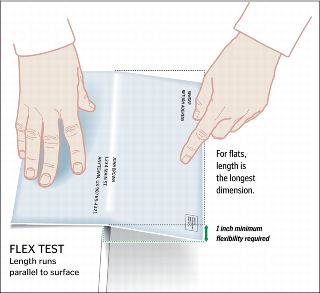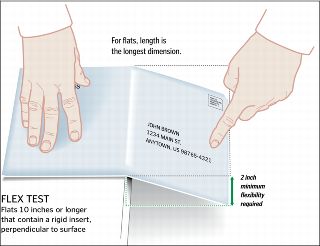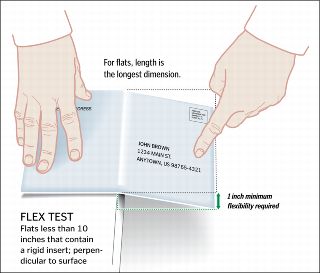The First-Class Mail International classification encompasses the categories of international mail that before May 14, 2007, were categorized as airmail letter-post and economy letter-post, postcards, and printed matter.
The weight limit for a letter-size First-Class Mail International mailpiece is 3.5 ounces. Letter-size items exceeding 3.5 ounces are charged the First–Class Mail International flat-size price.
Letter-size mail must be rectangular and must meet the following dimensions:
- Not less than 5-1/2 inches long or 3-1/2 inches high or 0.007-inch thick.
- Not more than 11-1/2 inches long or 6-1/8 inches high or 1/4-inch thick.
Note: For the purpose of determining mailability or machinability of a letter-sized piece, the length is the dimension parallel to the delivery address as read, and the height is the dimension perpendicular to the length.
Light-colored envelopes that do not interfere with the reading of the address and postmark must be used. Brilliant colored envelopes are not authorized.
Envelopes and packaging materials must be constructed to be strong enough to withstand normal handling. Highly glazed paper or paper with a design that affects readability or processing is not acceptable.
Envelopes and cards that have green bars or red- and blue-striped borders may be used for the sending of First-Class Mail International items.
Address windows for letter-size envelopes must be used under the following conditions:
- The address window must be parallel with the length of the envelope and must be in the lower portion of the address side.
- Nothing but the name, address, and any key number used by the mailer may appear through the address window.
- The return address should appear in the upper-left corner. If there is no return address and the delivery address does not show through the window, the piece is handled as undeliverable mail.
- The address disclosed through the window must be on white paper or paper of a very light color.
- When used for Registered Mail, window envelopes must conform to the conditions in DMM 503.
- All window envelopes for international mail must include a transparent material covering the window opening — i.e., open-panel envelopes are not acceptable.
Regardless of a letter’s weight, a per-piece surcharge (see Notice 123, Price List) applies to a First-Class Mail International letter that is nonmachinable for any of the following reasons:
- Has an aspect ratio (length divided by height) of less than 1.3 or more than 2.5.
- Is polybagged, polywrapped, or enclosed in any plastic material.
- Has clasps, strings, buttons, or similar closure devices.
- Contains items such as pens, pencils, or loose keys or coins that cause the thickness of the mailpiece to be uneven.
- Is too rigid (does not bend easily when subjected to a transport belt tension of 40 pounds around an 11-inch diameter turn).
- Is more than 4-1/4 inches high or 6 inches long and less than 0.009 inch thick.
- Has a delivery address parallel to the shorter dimension of the mailpiece.
Each postcard claimed at a card price must be rectangular and must meet the following dimensions:
- Not less than 3-1/2 inches high or 5-1/2 inches long or 0.007 inch thick.
- Not more than 4-1/4 inches high or 6 inches long or 0.016 inch thick.
Note: Unenclosed cards exceeding the size limits for postcards are mailable at the First-Class Mail International letter price if they do not exceed 4-3/4 inches high or 9-1/4 inches long.
Light-colored cards that do not interfere with the reading of the address and postmark must be used. Brilliant colored cards are not authorized.
Cards must be constructed to be strong enough to withstand normal handling. Highly glazed card stock or card stock with a design that affects readability or processing is not acceptable.
To claim the card price, postcards must meet the following conditions:
- Postcards must consist of single cards sent without a wrapper or envelope.
- Privately manufactured postcards, except picture postcards, must bear the heading “Postcard.”
The right half of the address side of a card must be reserved for the address of the addressee and postal notations or labels.
The left half of the address side of the card and the reverse side can be used for a message or permissible attachments. If a return address is used, it must appear in the upper-left half of the address side.
The following attachments may be applied to a postcard as noted, provided the attachment is made of paper or other thin material and adheres completely to the card:
- To the left half or the back side of the card: clippings of any kind, illustrations or photographs, or labels other than address labels.
- Only to the back side of the card: stamps likely to be confused with postage stamps.
- Only to the address side of the card for addressing purposes: address labels.
The following attachments to a card are not acceptable:
- An attachment that is not made of paper.
- An attachment that does not totally adhere to the card surface.
- An attachment that is an encumbrance to postal processing.
Folded (double) cards must be mailed in envelopes at the First-Class Mail International letter price.
The weight limit for a First-Class Mail International large envelope (flat) is 4 pounds.
Large envelopes (flats) must meet the following dimensions and characteristics:
- More than 11-1/2 inches long or 6-1/8 inches high or 1/4-inch thick.
- Not more than 15 inches long or 12 inches high or 3/4-inch thick.
- Flexible (see 241.236).
- Rectangular.
- Uniformly thick as stated in 241.235.
Note: The length of a large envelope (flat) is the longest dimension. The height is the dimension perpendicular to the length. A First-Class Mail International large envelope (flat) that does not meet the standards in 241.23 is not eligible for the large envelope (flat) size price and is charged the applicable First-Class Package International Service (small packet) price.
Light-colored envelopes that do not interfere with the reading of the address and postmark must be used. Brilliant colored envelopes are not authorized.
Flats must be constructed to be strong enough to withstand normal handling. Highly glazed paper or paper with a design that affects readability or processing is not acceptable.
Large envelopes (flats) must be uniformly thick so that any bumps, protrusions, or other irregularities do not cause more than a 1/4-inch variance in thickness. When determining variance in thickness, exclude the outside edges of a mailpiece (1 inch from each edge) when the contents do not extend into those edges. Also, exclude the selvage of any polywrap covering from this determination. Mailers must secure nonpaper contents to prevent shifting of more than 2 inches within the mailpiece if shifting would cause the piece to be nonuniform in thickness or would result in the contents bursting out of the mailpiece.
Large envelopes (flats) must be flexible. Boxes with or without hinges, gaps, or breaks that allow the piece to bend are not considered large envelopes (flats). Tight envelopes or wrappers that are filled with one or more boxes are not considered large envelopes (flats). Customers have the option to perform the tests described below and illustrated in Exhibit 241.236a–Exhibit 241.236c on their own mailpieces. When a Postal Service employee observes a customer demonstrating that a flat-size piece is flexible according to these standards, the employee does not need to perform the test. Test flats as follows:
- All large envelopes (flats) (see Exhibit 241.236a):
- Place the piece with the length parallel to the edge of a flat surface and extend the piece halfway off the surface.
- Press down on the piece at a point 1 inch from the outer edge, in the center of the piece’s length, exerting steady pressure.
- The piece is not flexible if it cannot bend at least 1 inch vertically without being damaged.
- The piece is flexible if it can bend at least 1 inch vertically without being damaged and does not contain a rigid insert. No further testing is necessary.
- If the piece can bend at least 1 inch vertically without being damaged but contains a rigid insert, test the piece according to 241.236b or 241.236c.
Exhibit 241.236a
Flexibility Test — All Large Envelopes (Flats)

Large envelopes 10 inches or longer that demonstrate the required flexibility in 241.236a but that contain a rigid insert (see Exhibit 241.236b):
- Place the piece with the length perpendicular to the edge of a flat surface and extend the piece 5 inches off the surface.
- Press down on the piece at a point 1 inch from the outer edge, in the center of the piece’s width, exerting steady pressure.
- Turn the piece around and repeat steps 1 and 2. The piece is flexible if both ends can bend at least 2 inches vertically without being damaged.
Exhibit 241.236b
Flexibility Test — Large Envelopes (Flats) 10 Inches or Longer

- Large envelopes less than 10 inches long that demonstrate the required flexibility in 241.236a but that contain a rigid insert (see Exhibit 241.236c):
- Place the piece with the length perpendicular to the edge of a flat surface and extend the piece halfway off the surface.
- Press down on the piece at a point 1 inch from the outer edge, in the center of the piece’s width, exerting steady pressure.
- Turn the piece around and repeat steps 1 and 2. The piece is flexible if both ends can bend at least 1 inch vertically without being damaged.
Exhibit 241.236c
Flexibility Test — Large Envelopes (Flats) Less Than 10 Inches Long
